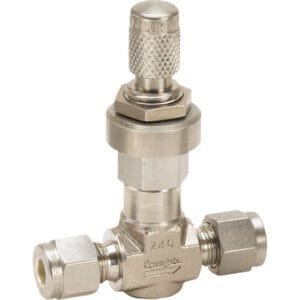Overview of ConFlat Flanges
The ConFlat (CF) flange is widely regarded as the industry standard for high vacuum and ultra-high vacuum (UHV) applications. Numerous gauges, instruments, accessories, and feedthroughs are compatible with this versatile flange system.
Blank (Blind) Flange
A blank or blind flange is a solid, disc-shaped fitting primarily used in vacuum systems to seal off unused sections of tubing or ports on vacuum chambers. These flanges can also be customized by machining to fit specific applications.
Sealing Mechanism
The CF flange achieves its leak-tight seal through a knife-edge design machined below the flat surface of the flange. As the bolts are tightened on a flange pair, the knife-edges create annular grooves on both sides of a soft metal gasket. This process extrudes the metal into surface defects and machining marks, resulting in a robust, leak-proof seal. The CF seal performs efficiently from atmospheric pressure (760 torr/103 mbar) down to less than 1 x 10⁻¹³ Torr (1.3 x 10⁻¹³ mbar), with an operating temperature range from -196°C to 450°C, depending on the materials used.
Size Nomenclature
In North America, CF flange sizes are typically referred to by their outside diameter (O.D.). However, in Europe and parts of Asia, the nomenclature commonly references the nominal internal diameter (I.D.), which reflects the largest tube size that can be welded to the bored flange.
Versions of ConFlat Flanges
ConFlat flanges come in two primary configurations:
- Fixed Flange: A single-piece design where the bolt-hole orientation is fixed relative to the fitting.
- Rotatable Flange: A two-part design comprising an inner weld ring and an outer bolt ring, allowing the bolt ring to rotate freely around the inner weld ring. This enables bolt hole alignment with mating flanges, irrespective of orientation.
Both fixed and rotatable flanges are available with either clearance holes or tapped holes.
Hole Options
- Clearance Holes: These through-holes provide enough space for bolts to pass through both flanges and are secured using nuts or plate nuts.
- Tapped Holes: These are imperial or metric threaded holes machined into the flange, allowing for direct bolt connections without the need for nuts or plate nuts. When choosing tapped flanges, it’s important to verify the bolt hole orientation to ensure compatibility with other components.
316LN Stainless Steel Features
316LN stainless steel offers several advantages for CF flanges, especially for vacuum applications:
- Hardness: With a Brinell Hardness rating of 170, 316LN is harder than 304L stainless steel, making it more suitable for chamber ports that require frequent disassembly.
- Electro-slag Remelt (ESR): This process improves grain homogeneity and eliminates gross macro-segregation, enhancing the overall material quality.
- Low Magnetic Permeability: The magnetic permeability of 316LN (µ ≤ 1.005) is lower than that of 304L stainless steel (µ = 1.03), making it ideal for applications that are sensitive to magnetic interference.





Reviews
There are no reviews yet.